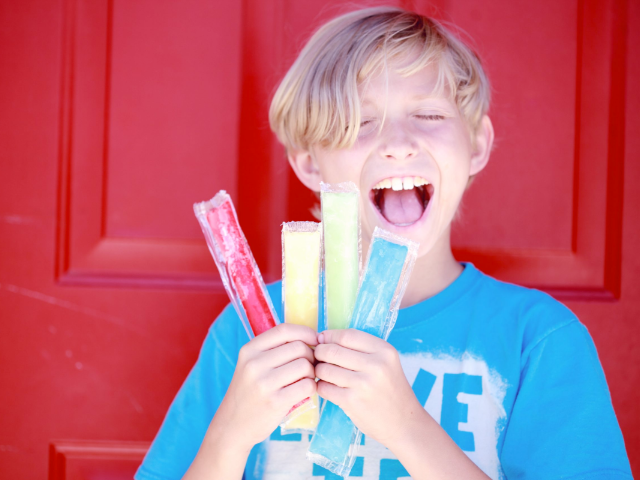In Part 1 and Part 2 about chewing/mouthing behavior in autism, I shared about potential underlying causes. In this final post of the series, I will focus on interventions and tools that you can use to help decrease and/or redirect your child’s chewing in order to both meet your child’s needs and keep him or her safe. Before I get into specifics, I want to stress the importance of looking at your child’s chewing behavior as a symptom of something else in his or her body. This is not an intentional behavior that needs to be corrected through discipline. Our kids are not chewing on things because they don’t know any better or want to be destructive, but they are doing it because it fills a need.
My son, who is nonspeaking and communicates through spelling, has explained that he knows he shouldn’t chew on certain things. However, it’s basically like his body acts without his permission. When we look at things from this perspective, our goal with interventions shifts from eliminating the behavior to meeting our child’s needs. Ultimately, both approaches may lead you to the same place, but, in my experience, the one you choose will make all the difference in how you and your child feel about the process.
So, that being said, here are some specific things you can do to help your child.
Create a safe environment
Because chewing or eating non-edible objects can lead to safety issues, the first step is to set up your child’s environment to eliminate potential dangers. Lock up any cleaners, soaps, or other chemicals to ensure they are not accessible. Keep an eye out for items that could cause a choking hazard and/or just be inherently dangerous to chew. Look out for things with sharp edges, magnets, batteries, etc.
It’s also important to pay close attention when new items, such as groceries or delivery boxes, come into the home. I learned this particular tip the hard way when my son got a hold of a stick-on thermometer from a temperature-sensitive package before I even realized it was there. I only discovered it when I found him with a blue tongue and lips from the substance inside the thermometer, which he had bitten open. Thankfully, this ended up being a non-toxic item. However, the time I spent waiting for Poison Control to research this and call me back felt like an eternity. This could have been avoided if I had inspected the package more closely.
Provide safe alternatives
In addition to removing unsafe items from the environment, it’s also helpful to add safe alternatives. Several companies sell items specifically designed to serve as safe and/or therapeutic options for children to chew on to help them meet their sensory needs. My favorite and the company I have the most experience with is Ark Therapeutic Products. They offer a large variety of options for colors, toughness levels, and styles (including both handheld and wearable options as well as pencil toppers), and they even provide information on their website about how to choose the right chew for your child. I also love that they have made an effort to offer styles of chews that will appeal to children, including some shaped like magic wands, flowers, and even lightsabers! (see their site here: https://www.arktherapeutic.com/)
Oral Motor Exercises
Exercises that work on oral motor control and strength can help reduce chewing behaviors by providing some of the input your child seeks through chewing. For some children, these activities can also help speech production. Some examples of oral motor exercises include:
Blowing Activities
Blow some bubbles, get musical with a harmonica, recorder, or whistle, blow through a straw to make bubbles in a drink, play a game with straws and cotton balls and try to blow the cotton ball past a set goal…the possibilities are endless! Make it fun, and join in!
Sucking Activities
Drinking through a straw, especially thick liquids like smoothies or milkshakes is another great way to provide some oral input. You can even try having your child “drink” foods like applesauce or pudding through a straw (basically, anything that makes the mouth muscles work a little harder). Krazy Straws are great for adding a little extra resistance to thinner liquids, and, as an added bonus, they’re just fun! Take the game with straws and cotton balls I mentioned above and reverse it…have your child suck through the straw to pick up a cotton ball (or tissue, etc.) and place it into a container. Get creative and have fun!
Crunchy or Chewy Foods
Raw veggies, apple slices, pretzels, crackers, and nuts are all great options for crunchy foods. Try raisins, fruit snacks, taffy, or even some gum for chewy options (be sure to supervise as necessary for your child). Simply eating these foods can provide extra sensory input and give those oral muscles a workout!
Oral Massage/Stimulation
Providing direct stimulation to the inside and outside of the mouth can be very helpful for some children. Outside of the mouth, you can gently but firmly massage your child’s lips, chin, jaw, and cheeks. Be sure to apply enough pressure so that it does not cause a tickling sensation, but follow your child’s cues to determine the “sweet spot” for them. To provide stimulation inside the mouth, you can try dental sponges, vibrating toothbrushes, or a z-vibe (this item, pictured below, is also available from Ark Therapeutic Products and can be used for a large variety of oral motor exercises). It may take some experimenting to figure out your child’s specific preferences.
With all of the above activities, being patient and respecting your child’s boundaries is important. If your child is resistant, start slowly and work your way up to a greater tolerance level, but never force! Not only will that defeat the purpose of regulating your child’s sensory systems, but it can also damage trust.
Provide proprioceptive input
As I mentioned in Part 2 of this series, some children chew because they crave sensory input that helps them to feel where their body is in space. Providing your child with whole-body input can also impact the need for oral input. Some examples of proprioceptive activities include massages, tight squeezes, jumping on a trampoline, squishing with pillows, push-ups, hanging from monkey bars or trapeze bars, vacuuming, carrying heavy grocery bags, tug-of-war, climbing, stomping, hitting a punching bag…and the list goes on! Basically, anything that provides resistance, pressure, or weight-bearing fits the bill.
Consult With Your Team
If you already have an occupational therapist and/or speech therapist working with your child, talk to them about your child’s chewing so you can enlist their experience to help guide activities. As the saying goes, two heads are better than one!




